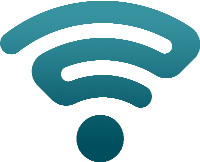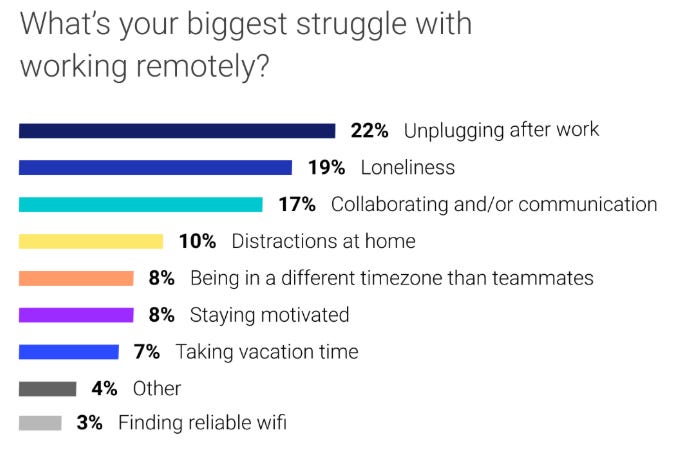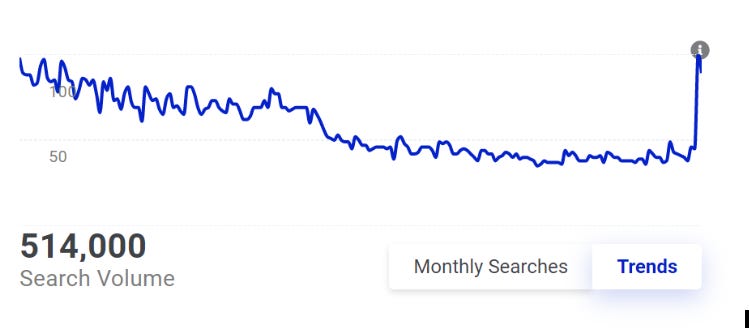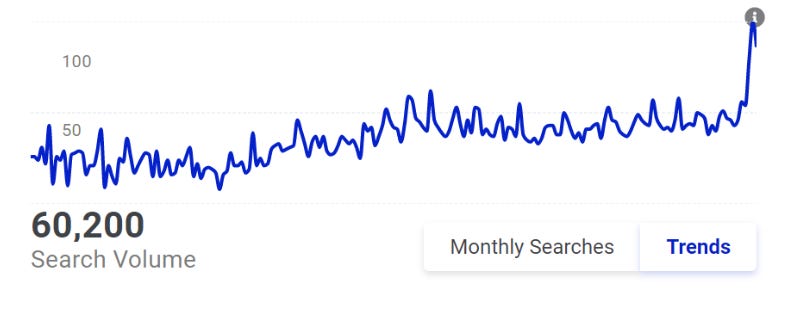⚡ Signal Special Edition - The Home Office

The Signal
Special edition
"Ideas Won't Keep. Something Must Be Done About Them."
Alfred N. Whitehead
Hello!
Welcome to our new members - great to have you. This was the highest growth week for the community, a 42% increase.
A very big thank you to those who have shared with friends.
Just in time for a special edition!
// FYI: Once a month I pick one business idea I like and dive into it. It's a brief playbook on how'd I'd start the business that you can use.
I'm particularly excited about this month's idea - 🏘️ Home office's.
(So excited, in fact, that I'll actually be doing this. I just love the topic and I need a 'showcase' project. If you want to climb on board - @ me or just reply to this.)
PS: Thanks to Sid Jha for the feedback on the landing page! He's got a super interesting newsletter - check it out.
Right, let's get into it!
The Breakdown
// The idea you can capitalize on this week.
Background
The coronavirus has forced our move towards a more decentralized economy to arrive sooner than we thought.
Big business is embracing it.
And why wouldn’t they, with a reported 47% increase in worker productivity from March and April 2020 versus a year prior (From 100 million data points across 30 000 US workers, from Prodoscore - an employee productivity tracking software.)
Google have announced the majority of their employees are going to be working from home until 2021 - at least.
Twitter CEO Jack Dorsey confirmed employees will be allowed to work from home (WFH) indefinitely.
Other large tech companies are following suit. Facebook, Salesforce and Slack have all said they don’t expect the majority of their workforce back in the office until at least 2021 - if then at all.
Slack’s CEO Stewart Butterfield has begun planning a future for his company where they down size their office desk requirement by 30% to 40%.
Working from home is the new normal.
The future of work has been ushered in - ready or not.
Problem
The average worker is not ready. We’re simply not geared to WFH yet.
The biggest problem? Switching off.
Multiple sources agree that the biggest challenge for remote workers is being able to draw a clear divide between work time, and ‘my’ time.

Data from: Buffer
Where previously the office was for work, and your commute back home signalled the end of the work day (for most), there is no clear divide anymore.
This leads to the WFH-ers working longer hours and making themselves available all the time.
Increased stress and burnout are possible side effects of not having clear work and normal life boundaries.
The Solution
Creating a clear divide between work and home life.
Build an audience on the subject of home-offices, and then monetize it.
A home-office is a place where people can go to (and leave from) at home, which allows them to work effectively. You're going to help them create that, through content.
The Lay of the Land
// What am I getting into?
Background
This is inspired by the “tiny home” trend which has a dedicated group of followers all interested in making small living spaces, whether it’s a self-contained unit, a van or shipping container-convert.
The search term “home office” gets 514 000 monthly searches, with a very sharp upward trend in the past few months.

Data from Mangools
With circa 60 200 monthly searches “home office ideas” also shows a steep growth in interest.

Data from Mangools
An interesting note here is the search trend on a more micro scale - 90 days.

Data from Google Trends.
The peaks of the graph after April 5th are during the week, and the troufs on the weekend. That would indicate that people are searching for a solution during the week, while they are at work, because it is a pain point.
Pain point = a business opportunity.
Players
Design outlets all produce content for home offices:
home-designing.com/
architecturaldigest.com/
dwell.com/
housebeautiful.com
houzz.com
Prefab offices:
alliedmodular.com/modular-offices/
www.panelbuilt.com/prefabricated-office/
www.curbed.com/2018/3/9/17091786/prefab-homes-shed-for-sale-cabins-backyard-office-studio
www.studio-shed.com/
Other Blogs:
supertinyhomes.com/backyard-offices/prefab-roundup
Tinyhomefor.us
Customer Profile
This is your ideal customer profile:
Gary is a 👨💼 40 year old tech manager who lives at home with his wife and 3 kids in California. Gary has transitioned to 🏠 working from home as a result of the Coronavirus and his company has taken the decision to allow employees to work at home indefinitely.
Gary has a 📜 college degree and earns an above average salary. He has a 💻 Macbook Pro and a desktop monitor which he uses for work. Gary has 💨 high speed internet and works with noise-cancelling headphones on.
He places value in being productive for periods of time and then switching off completely. In his down time Gary likes 🏃♂️ running and building model boats. He and his dad used to sail together when he was a kid.
Gary needs a place where he can be productive outside of the busy house where his 🚸 3 young children are during the day. He values the 🌿 aesthetics of his work space and wants it to be a calm, comfortable environment.
When Gary 📦 shops online, he always looks at reviews first. He would rather spend 40% more on something and know that it is high quality and will last. He prefers to shop from local businesses.
Getting Started
// Getting your first paying customers. Money in the bank, baby!
The POA looks something like this:
Step 1: Build an audience
Step 2: Become an authority in the niche
Step 3: Sell related products
It’s a fairly standard “start a blog” playbook. Here’s how we’ll make it work:
Step 1: Build an Audience
One of the temptations when starting a blog is trying to go too wide.
To be successful here, we want to focus on the problem: Creating a separate workplace at home.
The content we create will be based entirely on that problem. A trick here will be differentiating the site from the architectural/design sites which are dominating these keywords.
Keywords:
Home office - 514 000 searches/mth.
Home office ideas - 60 200 searches/mth.
Office home - 17 800 searches/mth.
Home office furniture - 31 000 searches/mth.
Home office design - 15 000 searches/mth.
Home office desk - 73 200 searches/mth.
A big trend seems to be the keyword “ideas” appended to most things related to a home office. That means people pay attention to what their home office looks like. Great.
There is a very healthy search volume and keyword difficulty isn't too high.
Email List:
An essential item. Prioritize capturing emails from the word go.
I’m generally against lead magnets. I think it is a recipe for creating a mostly uninterested email list. However, for a site that is as emotionally and visually appealing as this will be, there’s an opportunity to convert a cold lead (one that would have likely only signed up to get access to the lead magnet) to a warm lead (one that will continue to use the website because the content is great and will likely purchase something in the future).
I’d go with a middle ground: a drip sequence. It provides value, it’s continued engagement, and it keeps you top of mind.
Mine would probably be something along the lines of “How to set up your home office for ultimate productivity - A 2 week guide”.
Social Media:
Visuals are going to play a huge role here.
Media has been a massive influence in the success of other similar niches like “van life-ing” (?). The standard format is a video where van-lifers give tours of their vans and create build videos.
I see this being a similar trend, though more image-based probably.
Tools I’d focus on: Pinterest and Instagram.
Growth Hack
Unless you want to do all the work yourself, encourage submissions. Create a community. Crowd-source your content.
Step 2: Become an Authority
Once you have developed an audience, you’ll need to position yourself as the go-to source for everything related to home offices.
To do that, you need to offer significant value to your audience, by speaking to their needs.
You’ll get an idea for what is most valuable from the content that you create and what resonates best with your audience.
An example situation:
One of your best performing posts was “Poor internet connection? Here’s how to set up your home office internet”. It got shared by your audience and a few people commented saying it was particularly helpful.
Internet is a big pain point. You then create a resource for “The 5 best routers for your home office” and give it away for free. Ideally you partner with an online retailer and offer a discount if they purchase a router using your coupon code.
By doing this, you’re ensuring repeated engagement and an invested audience.
Step 3: Sell related products
Once you’ve developed an audience and are reaching 50k to 100k readers per month, you'll be able to monetize effectively (not that you should only start once you've hit this goal).
The example above illustrates one method of doing it.
This is what I’d do, summarized:
Affiliate marketing;
Targeted advertising (Strategic partnerships with different players like Home Depot, online plant stores etc.);
eBooks (On topics like: 25 Science-Backed WFH Productivity Hacks)
Courses (On topics like: How to Build Your Own Backyard Home Office)
Growth Hack
Partner with young brands which compliment your offering (think indoor plants, standing desks etc.) and run a “tag a friend” competition on Instagram to boost your followers.
You’ll have to put a bit of skin in the game here - so make sure it’s worth your while.
Let's Grow
// First customers in the bag. Now let's make a proper business of it.
If you'd like to read more, check out the full post here.
// Let's grow is how we take the business from 100 customers to 1000.
Clickworthy
// Valuable tidbits from around the interweb.
🏡 If this doesn't get you excited about home-offices and creating your own little "work-pod", I'm not sure what will.
🌵 Have indoor plants become part of your work space? Check out this community for indoor plants.
🖱️ The no code revolution is happening. Here's a free guide to the big players in the game, from one of the big players in the game - Webflow.
💡 What your business can learn from the coronavirus toilet paper debacle.
The End Notes
// I know, I know. I can almost hear you saying "Don't go, don't go."
I'll be back in next week with the regular Signal.
Did you like this special edition?
👍 YES - I liked it
🌫️ MEH - Average (Prefer the normal edition)
👎 NO - Pointless
If you've found this interesting, valuable or entertaining, a few of your friends might too. Please forward on to them.
See you next week, thanks for reading!
- Simon
PS: As always - I'd appreciate your feedback, please? (or you can just reply to this)


